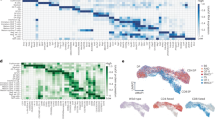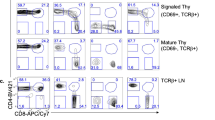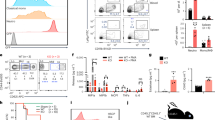Abstract
Development of immature T-cell precursors (thymocytes) to either the CD4 helper or CD8 killer T-cell lineages correlates precisely with their T-cell receptor specificity for major histocompatibility complex class II or class I molecules, respectively, indicating that the process is carefully regulated. Although intensively studied owing to its importance in determining the composition of the mature T-cell compartment and as a general model of binary lineage decisions, the underlying molecular pathways remain obscure. We have previously reported a spontaneous mouse mutant (HD (helper deficient) mice) in which lineage commitment is specifically perturbed without affecting positive selection. Here we show that a point mutation in the zinc finger transcription factor Th-POK (T-helper-inducing POZ/Krüppel-like factor) is responsible for redirection of class-II-restricted thymocytes to the CD8 lineage in HD mice. Furthermore, we demonstrate that constitutive expression of this factor during thymic development leads to redirection of class-I-restricted thymocytes to the CD4 lineage, indicating that Th-POK is a master regulator of lineage commitment.
This is a preview of subscription content, access via your institution
Access options
Subscribe to this journal
Receive 51 print issues and online access
$199.00 per year
only $3.90 per issue
Buy this article
- Purchase on SpringerLink
- Instant access to full article PDF
Prices may be subject to local taxes which are calculated during checkout






Similar content being viewed by others
References
Germain, R. N. T-cell development and the CD4–CD8 lineage decision. Nature Rev. Immunol. 2, 309–322 (2002)
Bosselut, R. & Singer, A. CD4/CD8 coreceptors in thymocyte development, selection, and lineage commitment: analysis of the CD4/CD8 lineage decision. Adv. Immunol. 83, 91–131 (2004)
Matechak, E. O., Killeen, N., Hedrick, S. M. & Fowlkes, B. J. MHC class II-specific T cells can develop in the CD8 lineage when CD4 is absent. Immunity 4, 337–347 (1996)
Itano, A. et al. The cytoplasmic domain of CD4 promotes the development of CD4 lineage T cells. J. Exp. Med. 183, 731–741 (1996)
Yasutomo, K., Doyle, C., Miele, L., Fuchs, C. & Germain, R. N. The duration of antigen receptor signalling determines CD4 + versus CD8 + T-cell lineage fate. Nature 404, 506–510 (2000)
Liu, X. & Bosselut, R. Duration of TCR signaling controls CD4–CD8 lineage differentiation in vivo. Nature Immunol. 5, 280–288 (2004)
Hernandez-Hoyos, G., Sohn, S. J., Rothenberg, E. V. & Alberola-Ila, J. Lck activity controls CD4/CD8 T cell lineage commitment. Immunity 12, 313–322 (2000)
Legname, G. et al. Inducible expression of a p56Lck transgene reveals a central role for Lck in the differentiation of CD4 SP thymocytes. Immunity 12, 537–546 (2000)
Schmedt, C. et al. Csk controls antigen receptor-mediated development and selection of T-lineage cells. Nature 394, 901–904 (1998)
Davé, V. P., Allman, D., Keefe, R., Hardy, R. R. & Kappes, D. J. HD mice: a novel mouse mutant with a specific defect in the generation of CD4(+ ) T cells. Proc. Natl Acad. Sci. USA 95, 8187–8192 (1998)
Keefe, R., Dave, V., Allman, D., Wiest, D. & Kappes, D. J. Regulation of lineage commitment distinct from positive selection. Science 286, 1149–1153 (1999)
Tyznik, A. J., Sun, J. C. & Bevan, M. J. The CD8 population in CD4-deficient mice is heavily contaminated with MHC class II-restricted T cells. J. Exp. Med. 199, 559–565 (2004)
Killeen, N. & Littman, D. R. Helper T-cell development in the absence of CD4-p56lck association. Nature 364, 729–732 (1993)
Galera, P., Musso, M., Ducy, P. & Karsenty, G. c-Krox, a transcriptional regulator of type I collagen gene expression, is preferentially expressed in skin. Proc. Natl Acad. Sci. USA 91, 9372–9376 (1994)
Klevit, R. E. Recognition of DNA by Cys2,His2 zinc fingers. Science 253, 1367–1393 (1991)
Nardelli, J., Gibson, T. J., Vesque, C. & Charnay, P. Base sequence discrimination by zinc-finger DNA-binding domains. Nature 349, 175–178 (1991)
Pui, J. C. et al. Notch1 expression in early lymphopoiesis influences B versus T lineage determination. Immunity 11, 299–308 (1999)
Zhumabekov, T., Corbella, P., Tolaini, M. & Kioussis, D. Improved version of a human CD2 minigene based vector for T cell-specific expression in transgenic mice. J. Immunol. Methods 185, 133–140 (1995)
Goldrath, A. W., Hogquist, K. A. & Bevan, M. J. CD8 lineage commitment in the absence of CD8. Immunity 6, 633–642 (1997)
Hernández-Hoyos, G., Anderson, M. K., Wang, C., Rothenberg, E. V. & Alberola-Ila, J. GATA-3 expression is controlled by TCR signals and regulates CD4/CD8 differentiation. Immunity 19, 83–94 (2003)
Widom, R. L., Lee, J. Y., Joseph, C., Gordon-Froome, I. & Korn, J. H. The hcKrox gene family regulates multiple extracellular matrix genes. Matrix Biol. 20, 451–462 (2001)
Tsai, S. F. et al. Cloning of cDNA for the major DNA-binding protein of the erythroid lineage through expression in mammalian cells. Nature 339, 446–451 (1989)
Blobel, G. A., Simon, M. C. & Orkin, S. H. Rescue of GATA-1-deficient embryonic stem cells by heterologous GATA-binding proteins. Mol. Cell. Biol. 15, 626–633 (1995)
Zheng, W. & Flavell, R. A. The transcription factor GATA-3 is necessary and sufficient for the Th2 cytokine gene expression in CD4 T cells. Cell 89, 587–596 (1997)
Hendriks, R. W. et al. Expression of the transcription factor GATA-3 is required for the development of the earliest T cell progenitors and correlates with stages of cellular proliferation in the thymus. Eur. J. Immunol. 29, 1912–1918 (1999)
Pai, S.-Y. et al. Critical roles for transcription factor GATA-3 in thymocyte development. Immunity 19, 863–875 (2003)
Taniuchi, I. et al. Differential requirements for Runx proteins in CD4 repression and epigenetic silencing during T lymphocyte development. Cell 111, 621–633 (2002)
Woolf, E. et al. Runx3 and Runx1 are required for CD8 T cell development during thymopoiesis. Proc. Natl Acad. Sci. USA 100, 7731–7736 (2003)
Aliahmad, P. et al. TOX provides a link between calcineurin activation and CD8 lineage commitment. J. Exp. Med. 199, 1089–1099 (2004)
Wilkinson, B. et al. TOX: an HMG box protein implicated in the regulation of thymocyte selection. Nature Immunol. 3, 272–280 (2002)
Kisielow, P., Bluethmann, H., Staerz, U. D., Steinmetz, M. & von Boehmer, H. Tolerance in T cell receptor transgenic mice involves deletion of immature CD4 + CD8 + thymocytes. Nature 333, 742–746 (1988)
Sawada, S., Scarborough, J. D., Killeen, N. & Littman, D. R. A lineage-specific transcriptional silencer regulates CD4 gene expression during T lymphocyte development. Cell 77, 917–929 (1994)
Acknowledgements
We acknowledge technical assistance with flow cytometry by J. Oesterling, and animal husbandry by members of the Laboratory Animal Facility. V.P.D. was responsible for initial genetic mapping of the HD mutation to a resolution of 4 cM. We thank D. Wiest for comments on the manuscript. This work was supported by National Institutes of Health Grants to D.J.K, an NIH Core Grant, and also an appropriation from the Commonwealth of Pennsylvania.
Author information
Authors and Affiliations
Corresponding author
Ethics declarations
Competing interests
The authors declare that they have no competing financial interests.
Supplementary information
Supplementary Figures 1-3
This file contains Supplementary Figures 1 (FACS analysis of thymocytes from male and female HY+ HD / and HD+/+ mice), 2 (FACS analysis of thymocytes and PBLs from BAC transgenic HD-/- mice demonstrating restoration of CD4 development) and 3 (northern blot analysis of Th-POK mRNA expression in various mouse tissues). (PDF 871 kb)
Supplementary Table 1
Results of BAC transgenic complementation analysis. (PDF 523 kb)
Supplementary Data
This file contains Supplementary Methods (details of genetic mapping and BAC complementation analysis), Supplementary Figure legends and Supplementary Table legend. (DOC 10 kb)
Rights and permissions
About this article
Cite this article
He, X., He, X., Dave, V. et al. The zinc finger transcription factor Th-POK regulates CD4 versus CD8 T-cell lineage commitment. Nature 433, 826–833 (2005). https://doi.org/10.1038/nature03338
Received:
Accepted:
Issue date:
DOI: https://doi.org/10.1038/nature03338
This article is cited by
-
ZBTB7B is a permissive regulator of hepatocellular carcinoma initiation by repressing c-Jun expression and function
Cell Death & Disease (2024)
-
ThPOK is a critical multifaceted regulator of myeloid lineage development
Nature Immunology (2023)
-
How autoreactive thymocytes differentiate into regulatory versus effector CD4+ T cells after avoiding clonal deletion
Nature Immunology (2023)
-
Markers and makers of NKT17 cells
Experimental & Molecular Medicine (2023)
-
The transcription factor LRF promotes integrin β7 expression by and gut homing of CD8αα+ intraepithelial lymphocyte precursors
Nature Immunology (2022)



